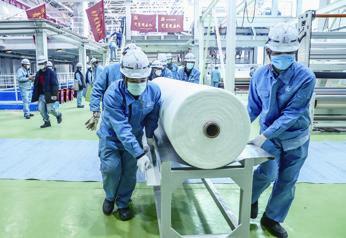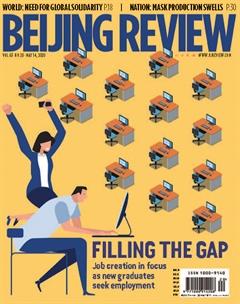Face Mask Frenzy
By Yuan Yuan

Hu Pingyu, co-founder of an electron- ics group in Zhejiang Province in east China, decided with his partners to switch their business to face mask production in early March in light of a sharp decline of orders for electronics amid the epidemic.
So his company invested about 60 million yuan ($8.4 million) and 40 days to build a brand new plant for medical masks. By the middle of April, the mask production line was put into operation.
“Quite a few companies I know, no matter what they made before, have shifted to face mask production,” Hu told Beijing Review. “My company was late to come around, but our investment was large.”
Hu didnt need to do any marketing since orders from existing clients kept the company working around the clock.“Medical masks are the most coveted commodity in the world today, and all the materials for producing a face mask have seen a jump in price,” Hu noted.
New production lines
The novel coronavirus outbreak has made medical masks top on the list of daily necessities for people, and the gap between the immense demand and the limited production capacity in China have led many, including big companies in seemingly unrelated industries, to switch into this sector.
For example, in early February, electronics giant and Apple iPhone manufacturer Foxconn, SAIC-GM-Wuling, a General Motors joint venture in China, and BYD, a major Chinese automaker, all announced switching part of their production lines to making medical masks.
BYD, in particular, took just two weeks to have its mask production lines up and running. Normally, these types of projects need at least two months to complete. Now, BYDs mask plant is running at full capacity, producing 5 million masks a day, making it the worlds largest face mask plant.
Statistics from the Ministry of Industry and Information Technology showed that since the outbreak, the number of newly registered medical mask plants surpassed 10,000, exceeding the total newly registered number in 2019, and the number is still growing.
Production in many mask plants hasnt gone smoothly, however. The largest obstacle in the early stages came from a severe lack of a critical material called meltblown nonwoven fabric, the middle layer of sandwich-structured masks.
Made of polypropylene, a chemical processed from petroleum, this layer is what makes a medical mask function by allowing the wearer to breath while keeping out possible infectious particles.
Before the epidemic, there were fewer than 60 companies in China producing this fabric, which basically met normal market demand, but is now far from adequate for the current pandemic.
However, though many companies swarmed into the mask production business, few dived into the production of this essential fabric. “To set up a production line for meltblown nonwoven fabric requires a much higher technical threshold,” said Nie Junjie, head of a plant producing the fabric in Hunan Province in central China.
Nie added that a large-scale production line of the crucial fabric needs an investment of at least 10 million yuan ($1.4 million) and it takes about six months for all machine parts to arrive. Professional adjustments on the machines and worker training are a must before operation. “In Hunan, there are only three companies that are capable of producing this fabric, each with a daily volume of two tons,” Nie said.
This has stopped many from starting a business in the fabric, causing its price to skyrocket since late January. Before the outbreak, the price for the fabric was less than 20,000 yuan ($2,800) per ton, but by the middle of February, it had soared to 150,000 yuan ($21,100) and by early March, it had reached 500,000 yuan ($70,400). Nevertheless, the fabric is still in short supply. Fueled by high prof its, some unlicensed workshops in east China rushed into the market with unqualified production lines of bad quality fabric, bringing chaos to the market.
But not only is this special fabric more expensive today, everything concerning the production of medical masks has also seen an incredible price hike. For instance, the price of machines for making face masks and fabrics have all increased at least threefold since the outbreak, while the price of regular nonwoven fabrics that are used to make the outer and inner layers of masks has risen six folds, even though they are in suffi cient supply.
Wu Wen, who runs a fabric plant in Guangzhou, capital city of Guangdong Province in south China, used the word “insane” to describe the market situation. “You have no idea what prices will be in the next hour or even the next minute,” Wu said on a video he posted online. “There are people who have money but are hesitant to invest, while there are others who have already entered the industry and are worried about whether they will win or lose.”

